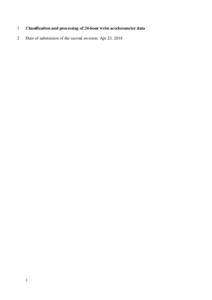Classification and processing of 24-hour wrist accelerometer data
Pulakka A; Shiroma EJ; Harris TB; Pentti J; Vahtera J; Stenholm S
https://urn.fi/URN:NBN:fi-fe2021042719576
Tiivistelmä
Background: An important step in accelerometer data analysis is the classification of continuous, 24-hour data into sleep, wake, and non-wear time. We compared classification times and physical activity metrics across different data processing and classification methods. Methods: Participants (n = 576) from the Finnish Retirement and Aging Study (FIREA) wore an accelerometer on their non-dominant wrist for seven days and nights and filled in daily logs with sleep and waking times. Accelerometer data were first classified as sleep or wake time by log, and Tudor-Locke, Tracy, and ActiGraph algorithms. Then, wake periods were classified as wear or non-wear by log, Choi algorithm, and wear sensor. We compared time classification (sleep, wake, and wake wear time) as well as physical activity measures (total activity volume and sedentary time) across these classification methods. Results: M (SD) nightly sleep time was 467 (49) minutes by log and 419 (88), 522 (86), and 453 (74) minutes by Tudor-Locke, Tracy, and ActiGraph algorithms, respectively. Wake wear time did not differ substantially when comparing Choi algorithm and the log. The wear sensor did not work properly in about 29% of the participants. Daily sedentary time varied by 8−81 minutes after excluding sleep by different methods and by 1−18 minutes after excluding non-wear time by different methods. Total activity volume did not substantially differ across the methods. Conclusion: The differences in wear and sedentary time were larger than differences in total activity volume. Methods for defining sleep periods had larger impact on outcomes than methods for defining wear time.
Kokoelmat
- Rinnakkaistallenteet [27094]
